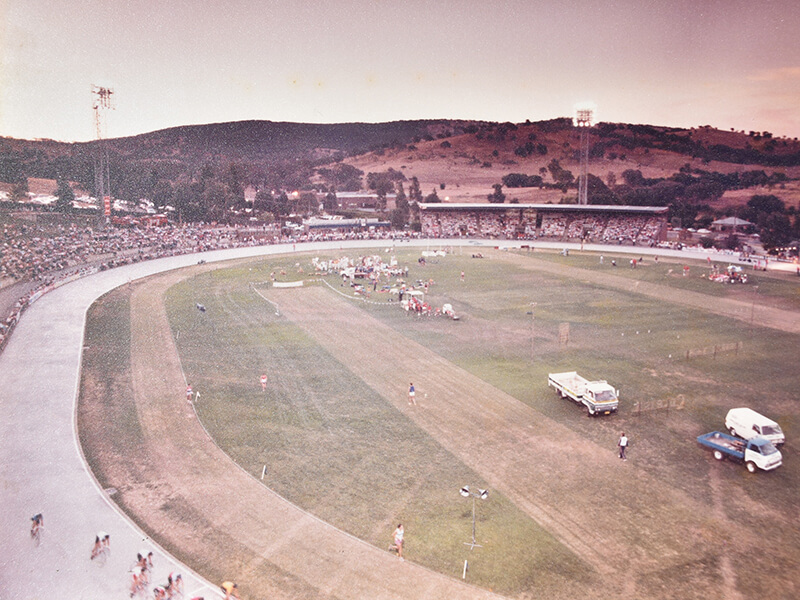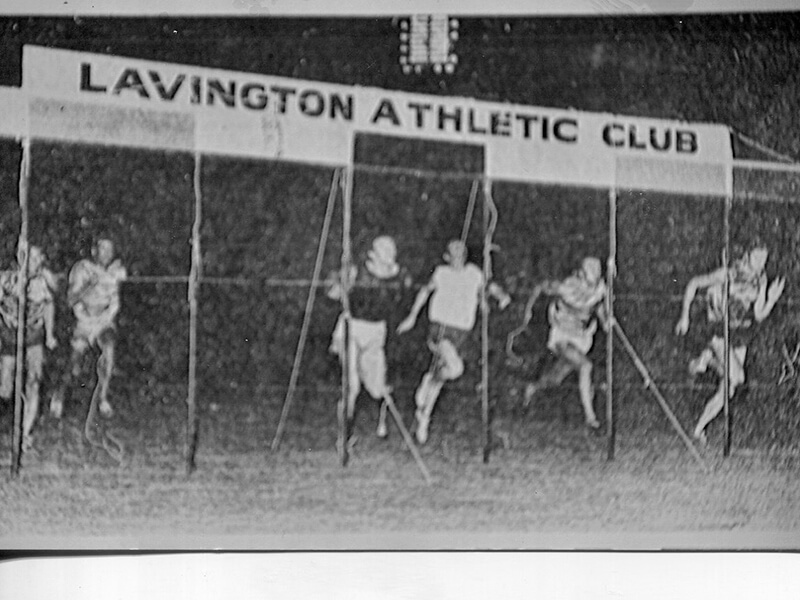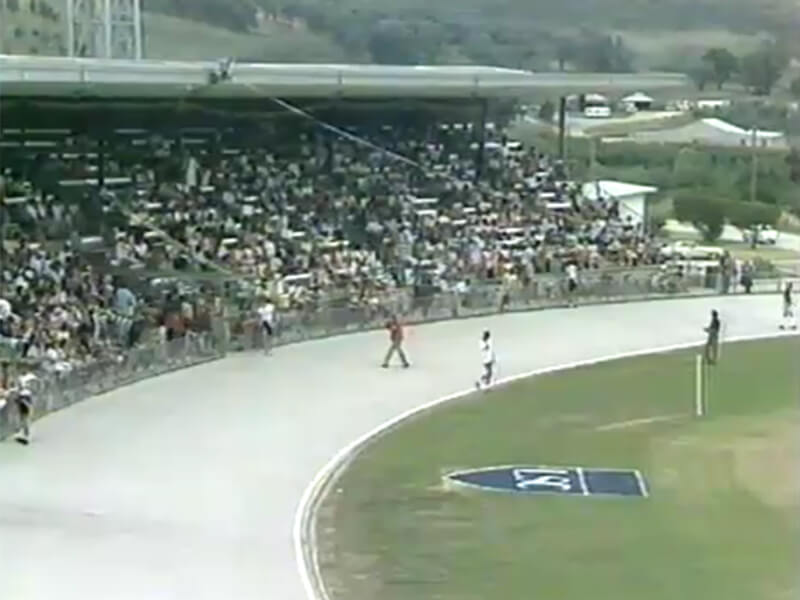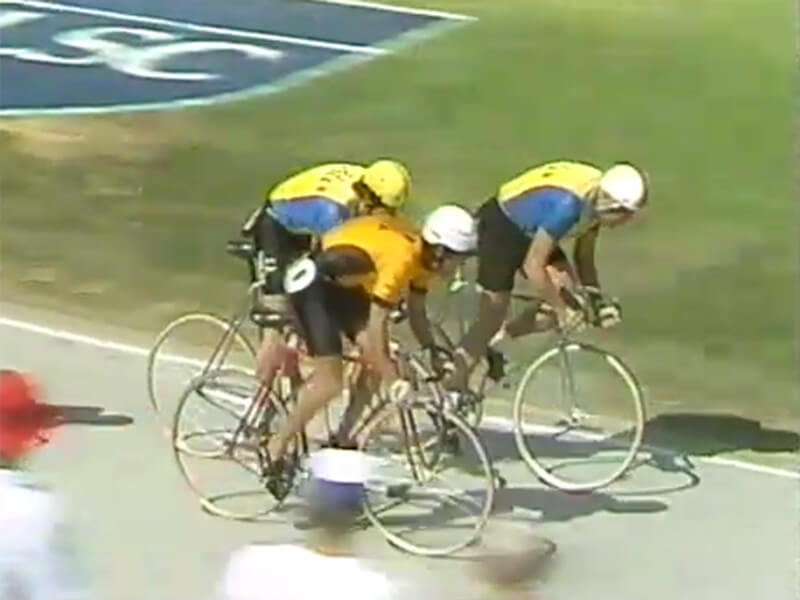Introduction
By Paul Terry, 2020
More than fifty years ago, a small group of locals had a vision to build a new sportsground in Lavington to encourage more people to play sport. That dream saw a former seminary and turkey farm evolving from humble beginnings to become the jewel of Albury’s sporting crown.
When the first oval at the fledgling Lavington Sports Ground opened in 1973, Lavington sports people had a place to call their own, along with a modest clubhouse that offered eight poker machines and included a “mixed lounge” so that women could attend.
Fast-forward 47 years and the sports ground that started through the drive and passion of local players and their supporters has become one of the best sporting venues in regional Australia, offering two grounds and admission to 20,000 spectators.
In true sporting style, the evolution of our premiere sporting venue was a saga of triumph and challenge – and eventually the entire community was crowned the winner when the $20M redevelopment of the former seminary reached its pinnacle with an official opening of the sports ground of the future in 2020.
Now, respected historian and journalist Howard Jones has compiled a detailed history of the ground from its genesis as the brainchild of Lavington sports enthusiasts to its current role as a flagship for first-class sport not only for Albury, but the entire region.
Lavington Sports Ground 1973-2020
By Howard Jones, 2020
Lavington Sports Ground is one of Australia’s premier outdoor venues for sport and entertainment thanks to $20 million of upgrades completed in 2020.
Half a century ago, a small group of sportsmen and supporters dreamt of creating a first-class facility that would get more locals, especially juniors, involved in sport.
The original oval opened in 1973 with a spectacular day-and-night athletics and cycling carnival, followed by football and cricket competitions. Over the years it staged numerous AFL and NRL pre-season football matches as well as Sheffield Shield and one-day international cricket. Non-sport use has ranged from Carols By Candlelight to an INXS concert and the Crusty Demons.
The Sports Ground was developed solely by the Lavington Sports Club, formed by 30 football and cricket players and supporters in 1964. Village football and cricket clubs had existed in Lavington since before 1914. They used the Urana Road recreation ground but it had primitive amenities. In 1964, the football and cricket clubs merged as a sports club intending to build a modest licensed venue next to the oval. Initially it had only £3000 in the bank.
By good fortune, the Divine Sword Missionaries wished to sell their seminary and turkey farm on Centaur Road and relocate to Queensland. While the Catholic priests involved were not too keen to see a “wet” club with poker machines, they saw it could foster local sports, particularly for juniors, the club’s principal aim.
The club, led by president Col Donnolley, first leased the seminary with an option to buy the 12 acres freehold for £4700 once liquor and gaming licences were secured. Volunteers renovated the premises but failed to gain licences, due to opposition from police and Lavington’s two pubs and the fact the club didn’t own freehold premises. Already the club was sponsoring five football teams and four cricket teams.
A “dry” clubhouse opened in April 1968, offering billiards and snooker, table tennis, carpet bowls and darts. Volunteers served soft drinks, snacks and Sunday lunches to keep the dream afloat. Soon there were 240 members. The ambitious Donnolley disclosed plans for “sporting fields, including a football oval, tennis courts and bowling greens”.
In 1969, despite protests from pubs and police, a licensed club was authorised. It opened as such on April 24, 1969, with eight poker machines. Legally, people under 21 could not join but women were admitted to a “mixed lounge”.
In mid-1970, the club paid $9000 for eight acres of grazing land opposite the club, to build a sports ground. Poker machine profits and a 5000 membership encouraged the club to “think big”. It borrowed $2 million in 1972 to build the oval, install floodlights and a grandstand. John Warren, a full-time sports co-ordinator, oversaw the project. Later the site was enlarged to almost 12 acres.
The grandstand name honours William George Hartley, a former Lavington Football Club president and a big fundraiser for the Sports Club, the Lavington swimming pool and fire brigade. Hartley a railwayman, had fought at Gallipoli and was wounded in action in France. He died in 1971.
The opening event on February 17 and 18 1973 was the Sports Carnival with $17,000 in prize money. It attracted 5000 spectators, starting the ball rolling for annual carnivals that ran to 1990. They brought in hundreds of competitors each year and thousands of spectators. Kevin Moloney won the first Lavington Gift worth $3500 and Frank Atkins the $5300 Wheelrace prize.
A night football carnival in March 1973 proved popular. There was plenty of drama, too. In one match, seven men were sent off for fighting! In April, the ground hosted a pre-season clash that saw Ovens and Murray teams Wodonga Bulldogs beat Albury Tigers. Ex-Collingwood star Max Urquhart had just been appointed to coach Lavington in the Tallangatta League and hopefully take the Saints into the O&M in 1974. Unfortunately, the O&M thwarted Lavington’s attempts at membership until 1979.
In 1974 the growing club considered building a basketball stadium, a golf course, a motel and a 2500-seat auditorium. A more cautious approach prevailed and the club focused on entertaining Australian and international stage acts. The newly-formed Albury-Wodonga Soccer Association used Lavington Sports Ground for pre-season matches in 1974 but the Sports Club was reluctant to continue that arrangement, fearing soccer might draw too many youngsters from Australian football!
Lavington carnivals figured large in national athletics and cycling calendars. They drew the cream of professional sprinters and cyclists and attracted up to 6000 spectators. There were three running tracks: one circling the oval and two straight ones inside. The 400 metres asphalt cycling track, slightly banked and coated with a special seal, was highly valued by amateur and professional riders for the fast speeds it allowed. Finals were generally held under lights. The 1975 carnival hosted the Australian Spring Championships and drew the first overseas cyclists.
By 1978, the carnival was offering $20,000 in prizes and now included woodchopping. The Australian professional cycling national championships were held at Lavington in 1980 and 1981. Olympic gold medallist Dean Woods won the 1985 Wheelrace in a thrilling finish with his good mate and fellow Olympian Glenn Clarke. The 1986 Lavington Carnival offered $30,000 in prize money for professional runners, cyclists and axemen, many of them renowned internationals such as world champion David Foster.
Lavington at last won entry to the Ovens and Murray Football League for the 1979 season. The Saints became the Blues because Myrtleford Saints were already in the league. The Blues won their first O&M premiership in 1983. Lavington hosted most O&M grand finals from 1981 to 2017. Meanwhile, a Super Rules (later Australian Masters) match between Melbourne and Canberra was played at Lavington in July 1982.
A Lavington Bowling Club with two greens was inaugurated by 16 men in 1983, with Frank Tracey as founding president. A ladies’ section started two years later.
Cricket assumed greater importance in the 1980s. The first Tooheys Cup match between Albury and Wagga was staged at Lavington in March 1980, using a hired portable aluminium wicket with matting. These matches continued up to 1987, drawing Test players such as Steve and Mark Waugh, Trevor Chappell and Doug Walters. A new turf wicket was laid in 1986.
In 1988 the Lavington Sports Club overruled cyclists’ objection and removed the asphalt cycle track, replacing it with a 250-metres velodrome built on the hill above the ground. This allowed oval dimensions to conform more closely to AFL standard sizes.
Racing cyclists familiar with the old track raised concerns about their safety on the velodrome. The first “Albury-Wodonga Wheelrace” on the velodrome in 1989 was also the last as many cyclists thought the surface was developing corrugations too dangerous for top-level racing. After the 1990 carnival, the Sports Club ended the event due to falling attendances and the club’s overall financial woes. (Under council ownership from 2009, the velodrome has had deficiencies remedied. An annual Albury-Wodonga Cycling Club Carnival for juniors began in 2010 and the velodrome has continued to be used for junior and senior training).
Going International
Club director Graeme Hicks’ efforts to have Lavington oval awarded first-class status for cricket led to a match between the NSW 2nd XI and NSW Combined Country in late 1988. Hicks then secured a promise of a Sheffield Shield match. The first was played between NSW and Victoria on December 15-18 1989. Star players included Mark Waugh and Geoff Lawson. Lawson was back for Lavington next coup, hosting a NSW v. England match on January 15-18 1991.
Meanwhile, an extremely hot day in October 1990 saw Australia, captained by Terry Daniher, beat Ireland in a combination of Australia football and Gaelic football at Lavington.
Hicks’ efforts organising a new Albury-Wodonga Festival of Sport secured international media coverage for Lavington on March 18 1992. A World Cup match saw Zimbabwe astonishingly beat England 135 to 125, with English captain Graham Gooch out for a duck. Sir Ian Botham naturally bowled well. The BBC broadcast the match worldwide, including some live TV.
That first Festival of Sport also featured the first AFL (Fosters Cup) match held at Lavington, with Sydney defeating Essendon before a crowd of 13,500. In 1993, Richmond thrashed the Swans. Over the next 23 years, no less than 13 AFL clubs played at Lavington in pre-season Fosters Cup, Ansett Cup, NAB Cup and other warm-up matches. The record gate was 20,169 for the Essendon-Carlton clash on March 20 1995.
Lavington Netball Club was formed in 1993 and fielded two teams in the Ovens and Murray League. For the first season they had no home court and used the J.C. King complex. In 1994 a court was built, but no change rooms or toilets. “The girls had to run down the hill and cross the oval to reach a toilet,” one recalled. A C grade team was added in 1996 and won the grand final next year, with A grade winning its first premiership in 1998. By then, a weather-cover shed had been built. Toilets were provided after the council took over the ground in 2009.
The Festival of Sport also embraced Rugby League, allowing Lavington to host the grand final of the Tooheys Challenge Cup in 1994 and 1995. The first final saw South Sydney Rabbitohs defeat Brisbane Broncos by one point. In 1995, 16,000 fans saw the Broncos defeat Cronulla-Sutherland Sharks 30-14.
Canberra Raiders played Melbourne Storm at Lavington on February 21 1997 in a pre-season match.
The 1998 Festival of Sport included a soccer match at Lavington between the Australian Olyroos (including Albury-Wodonga’s Archie Thompson and Peter Ritchie) and a Carlton youth team.
Enter The Panthers
No one in the 1970s could have predicted a rugby league club would one day operate Lavington Sports Ground. But the club debt worsened and in 1998 the oval, bowling greens and adjoining land were put up for sale. The city council voted 5-4 not to buy the oval. Some land near the bowling greens was sold for private housing. In 2001 the entire Sports Club operation went into liquidation. It was “saved” by being taken over by Penrith Panthers through the Panthers Entertainment Group. Panthers’ generous sponsorship led to the football, netball, cricket and cycling clubs being restyled Lavington Panthers.
From 2000 to 2002, the Murray Kangaroos (a joint venture between the O&M League and North Melbourne) used Lavington for their home games in the VFL. Three AFL pre-season matches were held during the Panthers ownership. Geelong defeated Essendon in March 2003 and Melbourne beat St Kilda in 2005, both events drawing 12,000 gates.
International soccer was played on January 18 2002 when the Matildas defeated South Korea 1-0. A football highlight in these years was Lavington Panthers winning the Ovens and Murray grand final in 2005. Skipper Darryn McKimmie, playing his 200th senior match, snared a major virtually on the siren to secure a one-point win over Myrtleford. From 2007 to 2010 the AFL declined to use the ground due to inadequate lighting for twilight matches failing to reach new standards.
Non-sport events included a Summerjam concert by INXS and Diesel in December 2003 and a Crusty Demons show in 2006.
Into AlburyCity Ownership
In July 2009 the city council bought the Sports Ground for $1.32 million, after the Panthers had failed to find a buyer. Intending to double the size of the ground, the council in 2012 bought 745 Centaur Road (4.56 hectares or just over 11 acres) for $865,000 and had it rezoned from residential to recreation.
The Panthers’ licensed club continued to 2014, when it closed permanently and the site sold. In 2018 the council bought the bowling greens freehold and leased them to Lavington Panthers Bowling Club.
In September 2010 the Sports Ground hosted the Group Nine Rugby League Grand Final for the first time, Tumut winning the premiership (Lavington Panthers winning the Reserve Grade).
The Sports Ground soon began the long road to redevelopment. In 2010 the council upgraded the lights to 500 lux at a cost of $500,000 and won back the AFL’s interest. As a result, Greater Western Sydney played North Melbourne in the NAB Cup in 2011, with the Giants meeting Gold Coast in 2012. There were also AFL pre-season matches in 2015 and 2017.
Channel Nine televised the NSW City versus NSW Country Rugby league clash in May 2011.
Melbourne Heart brought A-League football to Lavington on February 9 2014 in a clash with Perth Glory that was memorable for the heat. Even though kick-off was delayed two hours to 5pm, it was 39.8 degrees when the match before 6000 fans started. It rose to 40.8 degrees, forcing three extra drink breaks to be called. Heart won 2-1 in a match shown live on pay-television.
Big Bash men’s and women’s matches were played at the ground in December 2016 and December 2017. Lavington last hosted the Ovens and Murray football Grand Final in 2017. A poignant occasion that year was the funeral service held on the ground for former player Karl Jacka, aged 35.
In December 2015, Council received $4.03M in funding through the Federal Government’s National Stronger Region Fund for the redevelopment, together with $3.5M committed by Council, $250,000from the AFL and commitments from the Lavington Panthers Football/Netball and Cricket Clubs. The redevelopment of the major elements of the facility commenced in late 2016, after the Master Plan was adopted by Council in April 2016.
In 2018 AlburyCity was also successful in receiving $3.15M through the NSW Government’s Regional Sporting Infrastructure Fund for Stage 3 of the project.
In 2020, AlburyCity proudly opened the redeveloped facilities at the ground, including the construction of a second oval, a new function room and a first-class grandstand extension with new change rooms and other amenities.
This work fulfilled a vision to create one of the best regional sporting grounds in Australia and the city now looks forward to hosting local, regional, national and international competitions at a venue that’s evolved from modest beginnings 50 years ago to a state-of-the-art sporting complex that will serve its community for many generations to come.
Note (not for publication). My sources for this included numerous reports in the Border Mail and Twin Cities Post, annual reports of the Lavington Sports Club, personal communication with Albury & Distroct Historical Society (Helen Livsey, Greg Ryan and Bruce Pennay), Graeme Hicks, Tony Ratcliffe, Happy Wetmore, Stuart Paul, Stephen Kilpatrick and Ron O’Farrell and an unpublished memoir by the late Col Donnolley.




